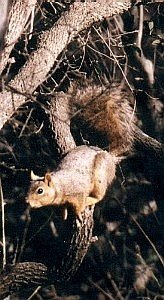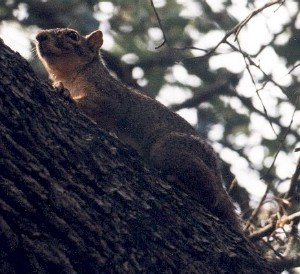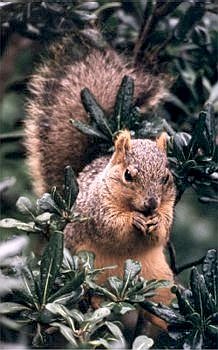Fox Squirrel
by Valerie (November 19, 2002)
One wild mammal spends much of its time in our yard, totally unafraid of us and the dog. Fox squirrels have been common in our area ever since the number of trees in neighboring yards increased to the bare minimum necessary for the animals to move about while feeling secure. With mature live oaks in several different stands, as well as pecans, other oaks, and a variety of miscellaneous trees, the squirrels have plenty of food and shelter while having to deal with a minimum number of predators.

Also called roof rats by people who are not fond of the rodents' destructive habits, squirrels are not closely related to rats, but belong to the same family as prairie dogs, chipmunks, and marmots. The species we have is the fox squirrel, which is the largest of the American tree squirrels. Although fox squirrels can come in a variety of colors from gray to black, the ones here in Austin are almost all the usual reddish gray color, with orange bellies. They are rather heavy animals and often make a loud thump when they jump onto the roof. This is then followed by the sound of them running, quite heavily, across to the opposite side. Tree squirrels are found on all continents except Australia and Antarctica. They do not hibernate during cold weather, but may spend a lot of time in tree hollow dens or nests made of leaves in order to conserve heat. These dens and nests are also used as nurseries for the tiny baby squirrels. Here in the South, the squirrels may raise two broods annually. The tail on tree squirrels is one of their most attractive features. Long and bushy, it is used for balance, warmth, as a sort of parachute to help with long leaps and as a communication device. Squirrels can frequently be heard making a variety of sounds and also flicking their tail as a visual signal. Although squirrels can live to be 20 years old in captivity, they often don't survive their first year because of traffic accidents. Those that avoid the cars usually live about 5 more years. While automobiles are the main cause of death among squirrels, they also fall prey to dogs and other mammalian predators, as well as hawks.
Being rodents, squirrels have four front incisor teeth that are long and curved. These grow continuously and wear down as the animal feeds. If they happen to misalign, they could grow unchecked and would eventually prevent the squirrel from feeding. The most aggravating habit of squirrels is their propensity to chew all the time. They not only use their teeth to gnaw into seeds and other food, but do things like tear bark off tree limbs (perhaps for the sweet sap underneath), sometimes girdling a whole branch which then dies. They also chew on houses. We have several places where they can sit on the roof and gnaw at the trim in a corner. This has been rather irritating and we tried various methods to keep them from this activity. Another problem squirrels cause is when they gain access to attics and set up housekeeping. They are very likely to damage insulation and wiring, and they need to be removed and their entry holes blocked off. Other, lesser problems caused by squirrels include digging up plants in gardens, making holes in sod and stealing seed from bird feeders. It is rather amusing to peruse the various essays available on the web, which range from "how to attract squirrels" to "how to solve squirrel problems." People often have strong opinions one way or the other.
Their destructive habits aside, squirrels are awfully cute and fun to watch. They have adapted well to an urban environment, if you don't count the number hit on roads, and are diurnal and so easily observed in a casual way. Our dog loves to chase them and gets a good amount of exercise as she runs around the yard, following their antics up in the trees.
Besides the problem with the house gnawing, squirrels are a rather neutral resident in our yard. One extremely helpful thing they have done is plant trees. They don't always select the most aesthetically pleasing spot for a tree, but they plant so many that we can just choose which seedlings to pull up and which to protect. All our pecan trees were planted by squirrels, as well as some red oaks. The squirrels are, of course, not really planting trees. They store nuts and acorns by burying them in the ground for use later. Since they bury a huge number and forget a portion, those that remain undisturbed are often at a perfect depth to germinate in the spring. The digging that they do when burying their food is minimal, probably because of our hard, clay soil. Squirrels are fairly clean animals and their droppings are not as noticeable as those of birds. However, our dog has decided that squirrel squat, which looks like small rabbit dung, is rather delectable (probably in the same category as rabbit raisins and Bambi burgers), and so spends a lot of time sniffing around in the grass looking for the disgusting little morsels. While it doesn't happen as often as with birds, because squirrels are up above us, they can relieve themselves in a less than desirable location. On a clear, sunny day, I once heard some dripping on the deck next to where I was sitting, and, upon looking up, saw a squirrel urinating from a tree branch up above. In spite of a few drawbacks, one might as well learn to live with them. Even if they were to be removed by trapping, more would move into the unoccupied territory, so we might as well just enjoy watching them. |
 Vaseline and pepper did not really do any good, and I would sometimes repair the damage with wood filler and fresh paint, but they kept at it. After our latest complete house painting this summer, I covered the trim board corners where they preferred to chew with thin layers of sheet tin, nailed down, caulked, then painted. From the ground these are barely noticeable. The squirrels made a few exploratory chew marks (they scraped off a bit of paint), but have since given up. As the "armor" took very little time to install, I can heartily recommend this method of house protection.
Vaseline and pepper did not really do any good, and I would sometimes repair the damage with wood filler and fresh paint, but they kept at it. After our latest complete house painting this summer, I covered the trim board corners where they preferred to chew with thin layers of sheet tin, nailed down, caulked, then painted. From the ground these are barely noticeable. The squirrels made a few exploratory chew marks (they scraped off a bit of paint), but have since given up. As the "armor" took very little time to install, I can heartily recommend this method of house protection.
